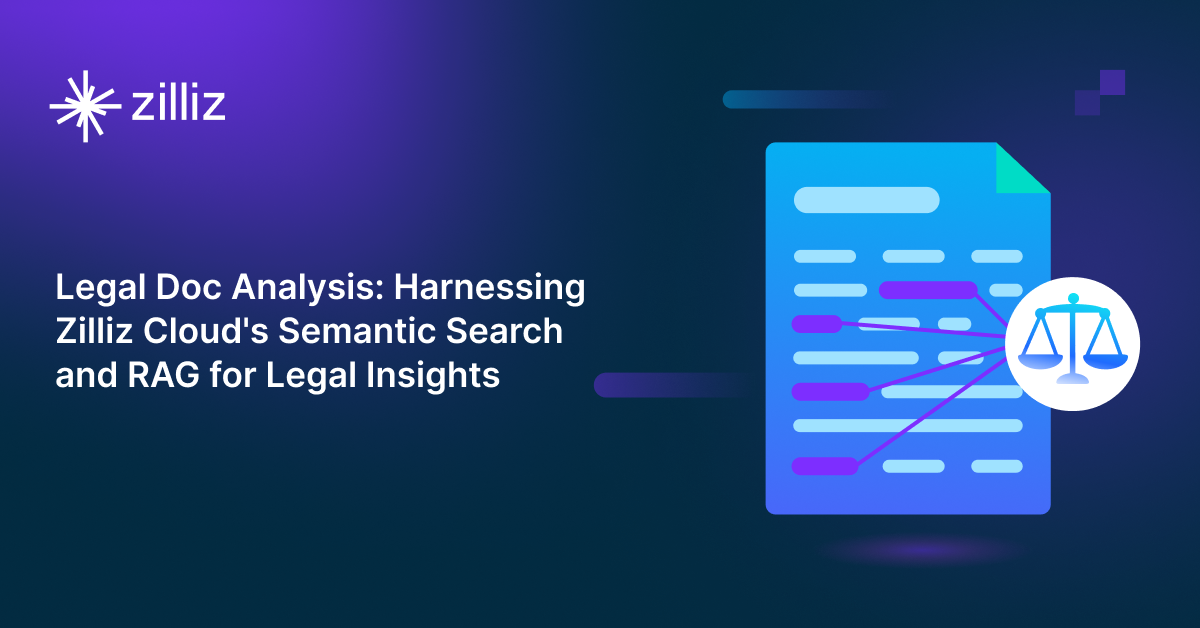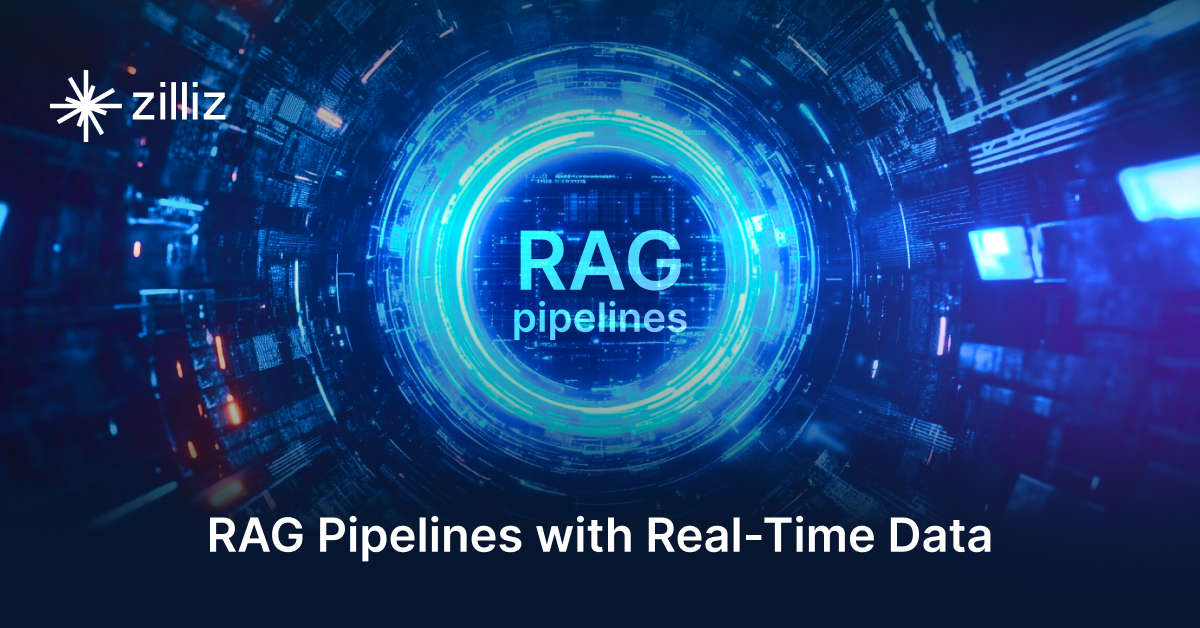Build RAG Chatbot with Llamaindex, HNSWlib, Gemini 1.5 Flash, and Ollama all-minilm
Introduction to RAG
Retrieval-Augmented Generation (RAG) is a game-changer for GenAI applications, especially in conversational AI. It combines the power of pre-trained large language models (LLMs) like OpenAI’s GPT with external knowledge sources stored in vector databases such as Milvus and Zilliz Cloud, allowing for more accurate, contextually relevant, and up-to-date response generation. A RAG pipeline usually consists of four basic components: a vector database, an embedding model, an LLM, and a framework.
Key Components We'll Use for This RAG Chatbot
This tutorial shows you how to build a simple RAG chatbot in Python using the following components:
- Llamaindex: a data framework that connects large language models (LLMs) with various data sources, enabling efficient retrieval-augmented generation (RAG). It helps structure, index, and query private or external data, optimizing LLM applications for search, chatbots, and analytics.
- HNSWlib: a high-performance C++ and Python library for approximate nearest neighbor (ANN) search using the Hierarchical Navigable Small World (HNSW) algorithm. It provides fast, scalable, and efficient similarity search in high-dimensional spaces, making it ideal for vector databases and AI applications.
- Gemini 1.5 Flash: A fast, streamlined AI model optimized for real-time applications and low-latency environments. While lightweight, it maintains high accuracy in text-based tasks, making it ideal for rapid document summarization, chatbot interactions, and AI-driven customer support with minimal computational overhead.
- Ollama all-minilm: A compact language model optimized for efficient NLP tasks, offering fast inference and low resource consumption. Strengths include scalability, versatility in text processing, and seamless integration. Ideal for real-time applications, edge deployments, and scenarios requiring lightweight yet robust language understanding.
By the end of this tutorial, you’ll have a functional chatbot capable of answering questions based on a custom knowledge base.
Note: Since we may use proprietary models in our tutorials, make sure you have the required API key beforehand.
Step 1: Install and Set Up Llamaindex
pip install llama-index
Step 2: Install and Set Up Gemini 1.5 Flash
%pip install llama-index-llms-google-genai llama-index
from llama_index.llms.google_genai import GoogleGenAI
llm = GoogleGenAI(
model="gemini-1.5-flash",
# api_key="some key", # uses GOOGLE_API_KEY env var by default
)
Step 3: Install and Set Up Ollama all-minilm
%pip install llama-index-embeddings-ollama
from llama_index.embeddings.ollama import OllamaEmbedding
embed_model = OllamaEmbedding(
model_name="all-minilm",
)
Step 4: Install and Set Up HNSWlib
%pip install llama-index-vector-stores-hnswlib
from llama_index.vector_stores.hnswlib import HnswlibVectorStore
from llama_index.core import (
VectorStoreIndex,
StorageContext,
SimpleDirectoryReader,
)
vector_store = HnswlibVectorStore.from_params(
space="ip",
dimension=embed_model._model.get_sentence_embedding_dimension(),
max_elements=1000,
)
Step 5: Build a RAG Chatbot
Now that you’ve set up all components, let’s start to build a simple chatbot. We’ll use the Milvus introduction doc as a private knowledge base. You can replace it with your own dataset to customize your RAG chatbot.
import requests
from llama_index.core import SimpleDirectoryReader
# load documents
url = 'https://raw.githubusercontent.com/milvus-io/milvus-docs/refs/heads/v2.5.x/site/en/about/overview.md'
example_file = 'example_file.md' # You can replace it with your own file paths.
response = requests.get(url)
with open(example_file, 'wb') as f:
f.write(response.content)
documents = SimpleDirectoryReader(
input_files=[example_file]
).load_data()
print("Document ID:", documents[0].doc_id)
storage_context = StorageContext.from_defaults(vector_store=vector_store)
index = VectorStoreIndex.from_documents(
documents, storage_context=storage_context, embed_model=embed_model
)
query_engine = index.as_query_engine(llm=llm)
res = query_engine.query("What is Milvus?") # You can replace it with your own question.
print(res)
Example output
Milvus is a high-performance, highly scalable vector database designed to operate efficiently across various environments, from personal laptops to large-scale distributed systems. It is available as both open-source software and a cloud service. Milvus excels in managing unstructured data by converting it into numerical vectors through embeddings, which facilitates fast and scalable searches and analytics. The database supports a wide range of data types and offers robust data modeling capabilities, allowing users to organize their data effectively. Additionally, Milvus provides multiple deployment options, including a lightweight version for quick prototyping and a distributed version for handling massive data scales.
Optimization Tips
As you build your RAG system, optimization is key to ensuring peak performance and efficiency. While setting up the components is an essential first step, fine-tuning each one will help you create a solution that works even better and scales seamlessly. In this section, we’ll share some practical tips for optimizing all these components, giving you the edge to build smarter, faster, and more responsive RAG applications.
LlamaIndex optimization tips
To optimize LlamaIndex for a Retrieval-Augmented Generation (RAG) setup, structure your data efficiently using hierarchical indices like tree-based or keyword-table indices for faster retrieval. Use embeddings that align with your use case to improve search relevance. Fine-tune chunk sizes to balance context length and retrieval precision. Enable caching for frequently accessed queries to enhance performance. Optimize metadata filtering to reduce unnecessary search space and improve speed. If using vector databases, ensure indexing strategies align with your query patterns. Implement async processing to handle large-scale document ingestion efficiently. Regularly monitor query performance and adjust indexing parameters as needed for optimal results.
HNSWlib optimization tips
To optimize HNSWlib for a Retrieval-Augmented Generation (RAG) setup, fine-tune the M parameter (number of connections per node) to balance accuracy and memory usage—higher values improve recall but increase indexing time. Adjust ef_construction (search depth during indexing) to enhance retrieval quality. During queries, set ef_search dynamically based on latency vs. accuracy trade-offs. Use multi-threading for faster indexing and querying. Ensure vectors are properly normalized for consistent similarity comparisons. If working with large datasets, periodically rebuild the index to maintain efficiency. Store the index on disk and load it efficiently for persistence in production environments. Monitor query performance and tweak parameters to achieve optimal speed-recall balance.
Gemini 1.5 Flash optimization tips
For Gemini 1.5 Flash, prioritize lightweight and high-speed retrieval to match its fast inference capabilities. Optimize document embeddings for quick similarity search and use pre-filtering techniques to reduce retrieval overhead. Maintain a small but high-quality context window by fine-tuning chunking strategies. Leverage caching for commonly accessed queries to minimize API calls. Monitor token usage and adjust retrieval scope dynamically to balance speed and response accuracy.
Ollama all-minilm optimization tips
Optimize Ollama all-minilm in RAG by preprocessing input text into concise, semantically meaningful chunks (256-512 tokens) to align with its context window. Use metadata filtering during retrieval to prioritize relevant documents and reduce noise. Fine-tune the model on domain-specific data to enhance answer relevance. Adjust temperature (0.2-0.5) and top-p (0.85-0.95) for balanced creativity and accuracy. Cache frequent queries to reduce latency, and employ batch processing for parallel inference. Quantize the model to 8-bit for faster inference with minimal accuracy loss. Regularly evaluate retrieval hit rates and answer quality to iteratively refine the pipeline.
By implementing these tips across your components, you'll be able to enhance the performance and functionality of your RAG system, ensuring it’s optimized for both speed and accuracy. Keep testing, iterating, and refining your setup to stay ahead in the ever-evolving world of AI development.
RAG Cost Calculator: A Free Tool to Calculate Your Cost in Seconds
Estimating the cost of a Retrieval-Augmented Generation (RAG) pipeline involves analyzing expenses across vector storage, compute resources, and API usage. Key cost drivers include vector database queries, embedding generation, and LLM inference.
RAG Cost Calculator is a free tool that quickly estimates the cost of building a RAG pipeline, including chunking, embedding, vector storage/search, and LLM generation. It also helps you identify cost-saving opportunities and achieve up to 10x cost reduction on vector databases with the serverless option.
 Calculate your RAG cost
Calculate your RAG cost
What Have You Learned?
Wow, what an incredible journey you've taken through this tutorial! You've learned how to harness the power of a dynamic framework, a robust vector database, a cutting-edge LLM, and an efficient embedding model to create your very own Retrieval-Augmented Generation (RAG) system. We explored LlamaIndex to structure your data intelligently, while HNSWlib served as your lightning-fast vector database, enabling quick and precise retrieval of relevant data. With Gemini 1.5 Flash at your fingertips, you discovered how to elevate your natural language processing capabilities, diving deep into complex queries with ease. And let's not forget about Ollama's all-minilm, which helped turn those gathered insights into rich, human-like responses. You truly have a toolkit that's bursting with potential!
But that's not all; remember the optimization tips you picked up along the way? These subtle tweaks can massively enhance performance, ensuring that your RAG system runs seamlessly. Plus, I hope you found the free RAG cost calculator to be a handy resource, putting you in control of your project budget. The exciting possibilities awaiting you as you begin to build, optimize, and innovate your own applications are limitless! So don’t hold back—roll up your sleeves and let your creativity flourish. You’ve got the knowledge and tools to make a significant impact, so get started today and watch your ideas come to life!
Further Resources
🌟 In addition to this RAG tutorial, unleash your full potential with these incredible resources to level up your RAG skills.
- How to Build a Multimodal RAG | Documentation
- How to Enhance the Performance of Your RAG Pipeline
- Graph RAG with Milvus | Documentation
- How to Evaluate RAG Applications - Zilliz Learn
- Generative AI Resource Hub | Zilliz
We'd Love to Hear What You Think!
We’d love to hear your thoughts! 🌟 Leave your questions or comments below or join our vibrant Milvus Discord community to share your experiences, ask questions, or connect with thousands of AI enthusiasts. Your journey matters to us!
If you like this tutorial, show your support by giving our Milvus GitHub repo a star ⭐—it means the world to us and inspires us to keep creating! 💖
- Introduction to RAG
- Key Components We'll Use for This RAG Chatbot
- Step 1: Install and Set Up Llamaindex
- Step 2: Install and Set Up Gemini 1.5 Flash
- Step 3: Install and Set Up Ollama all-minilm
- Step 4: Install and Set Up HNSWlib
- Step 5: Build a RAG Chatbot
- Optimization Tips
- RAG Cost Calculator: A Free Tool to Calculate Your Cost in Seconds
- What Have You Learned?
- Further Resources
- We'd Love to Hear What You Think!
Content
Vector Database at Scale
Zilliz Cloud is a fully-managed vector database built for scale, perfect for your RAG apps.
Try Zilliz Cloud for Free


